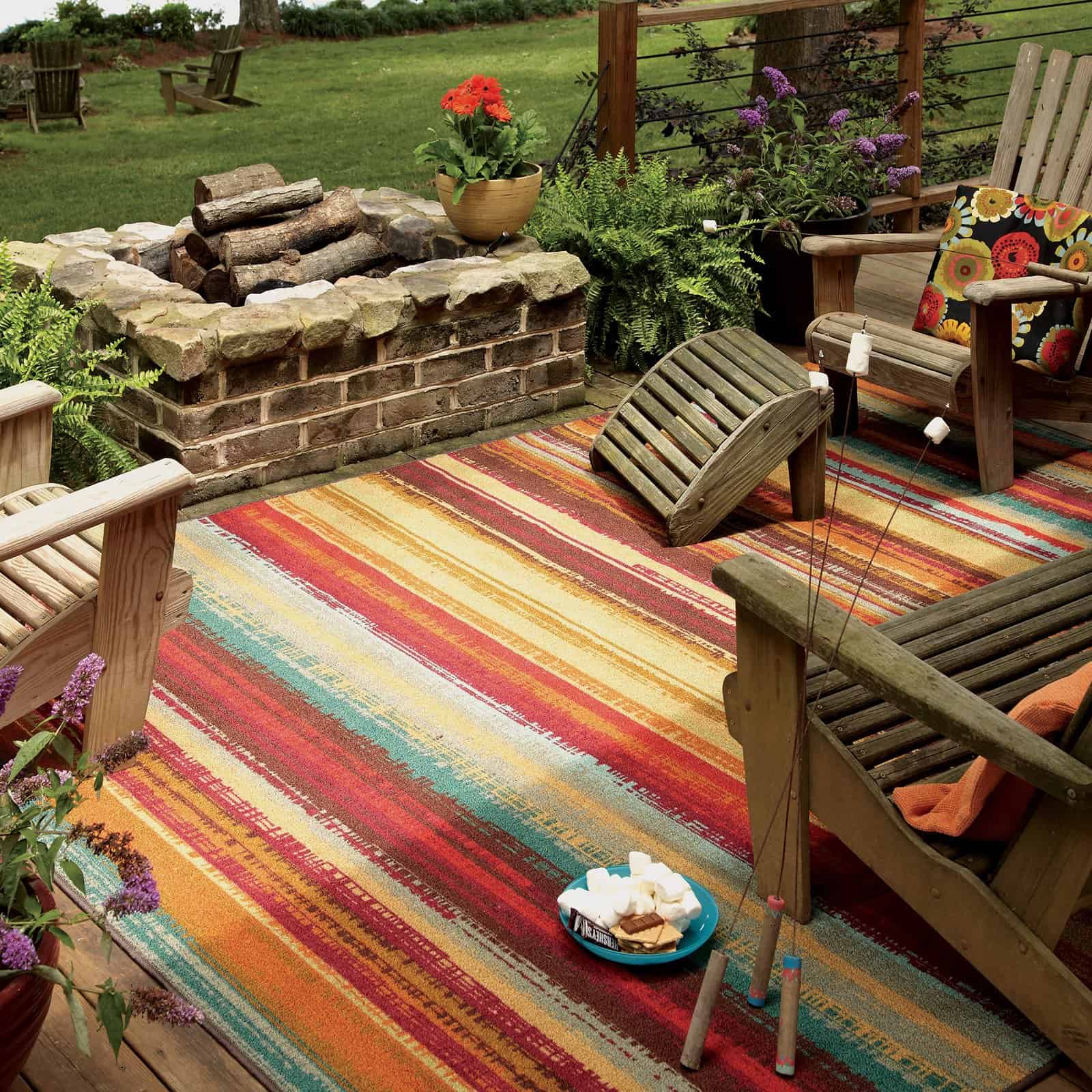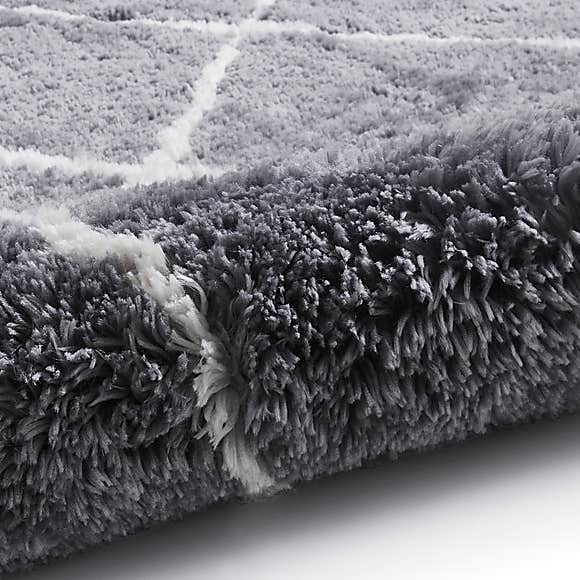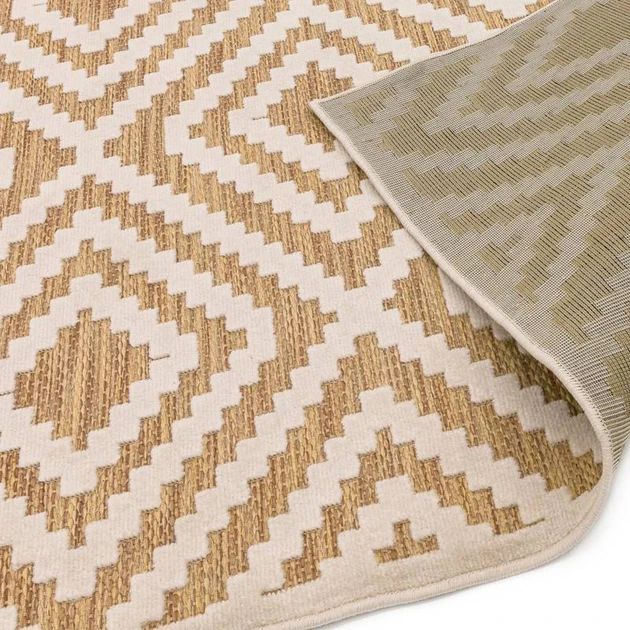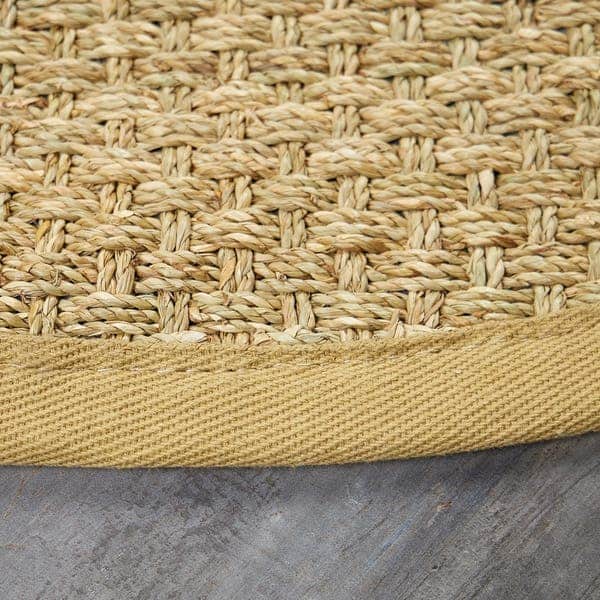The best outdoor rugs are typically made from polypropylene or polyester. Both synthetic rug materials are strong and durable. They can handle high foot traffic and diverse weather conditions. They don’t absorb moisture and are mold-resistant, unlike the majority of natural rug materials.
Does your patio look out of place? Would you like to bring that cozy indoor charm outdoors?
I know just what will make your backyard look more welcoming – an outdoor rug! An outdoor rug will complete your patio sitting area and make it look like the extension of your home.
But before you start shopping, you first need to familiarize yourself with different materials. Not every textile works in every outdoor setting.
So, what is the best material for outdoor rugs?
I will take you through all the viable synthetic and natural options. Let’s take a look.
Contents
Find Best Material For Outdoor Rugs
Synthetic Fiber Options
Polypropylene
Best for: Damp, humid climates with high foot traffic.
Polypropylene, often called olefin, is the most common material used in outdoor rugs.

Polypropylene is strong, durable, and resistant to weather. It doesn’t absorb moisture, either from rain, or accidental drink spillage. The fiber doesn’t grow mold and mildew, which makes it ideal for damp and humid climates.
Polypropylene handles the sunlight just as well. Your UV treated polypropylene rug won’t fade in color, so you can enjoy its vibrant look season after season.
Polypropylene rugs come in many different colors, patterns, and textures. They make for a great statement piece.
Here is how you clean a polypropylene outdoor rug:
Polyester
Best for: Damp, humid climates with moderate foot traffic.
Polyester is another durable and long-lasting outdoor material that is resistant to mildew, fading, and weather. The fabric repels stains, except for oil-based ones, which are harder to clean. I don’t recommend using this rug underneath an outdoor dining table.

Polyester rugs tend to shed fibers a little bit faster than other synthetic materials, so keep this in mind if you have lots of busy feet running around your house.
On the bright side, polyester imitates natural fibers for just a fraction of the price. Rugs made of polyester can be used indoors and outdoors and some brands use it extensively in their collections.
Nylon
Best for: Dry climates and shaded outdoor places with high foot traffic.
Rugs made of nylon are strong, durable, and colorfast. They are ideal for high-traffic areas because they don’t wear down easily. If you plan on hosting lots of outdoor get-togethers, I highly recommend you consider this option.

However, I also recommend that you keep your nylon rug in a shaded area since the material can get very hot and build static electricity when left out in the sun.
Nylon also absorbs stains, unlike polypropylene, which repels them. I recommend you spray down your nylon rug with a special rug protector (for example, Scotchgard Rug & Carpet Protector) to keep stains from soaking in. One can of treatment covers a 5×6 square foot area. Check it out:
Acrylic
Best for: Diverse climates and covered patios with moderate foot traffic.
Acrylic rugs feel amazing under feet. They are best known for their soft, warm, and luxurious texture that can be compared to the natural fiber of the wool. Despite that, acrylic rugs are still much cheaper per square foot than wool rugs.

Acrylic fiber is resistant to sunlight degradation, moths, chemicals, and oil stains. But unlike polypropylene, acrylic fiber absorbs moisture. Luckily, it releases it quickly. This, in turn, makes the mold and mildew hard to grow.
Acrylic rugs retain their shape after washing. But, lower grade acrylic rugs may pill and warp faster.
Natural Fiber Options
Bamboo
Best for: Dry climates and covered patios with low foot traffic.
Bamboo rugs are a great addition to any roofed outdoor space. They are durable and naturally resistant to fire, insects, and allergens. The bamboo surface is smooth and easy to clean, unlike other fibrous textiles.

Your bamboo rug won’t develop a static charge but will be louder than your average carpet when walked on, so placing a bamboo rug in an area where people walk a lot may not be the best idea. Avoid putting it in direct sunlight, as well, to keep it from fading.
Jute
Best for: Dry climates and covered patios with medium foot traffic.
Jute is an eco-friendly fiber, primarily made of plants from the Corchorus genus. Only stalks of the plants are used to make jute and burlap. The plant material is first soaked, stripped, and spun into a durable thread to make rugs, storage baskets, shopping bags, and other rustic-looking goodies, like the ones you can buy here.

Natural fibers are typically highly absorbent, and jute is no exception to this. Jute easily grows mold when it gets wet, which makes it harder to clean and keep outdoors. The best way to keep your precious rug intact is to vacuum it regularly and keep it under a covered patio or pavilion.
Sisal
Best for: Dry climates and covered patios with high foot traffic.
Sisal, or agave, is the toughest natural fiber in this group. It can handle high foot traffic and doesn’t show wear and tear easily.

Its durability comes at a cost. Sisal rugs are coarse and not as pleasant on the bare feet as other natural options. You should keep this in mind if you have a bunch of sockless kids running around.
You also shouldn’t keep your sisal rug in an open outdoor area, because it easily absorbs moisture, just like jute. It is best if you keep it under a roof at all times and avoid using water and steam cleaners on it.
Seagrass
Best for: Diverse climates and covered patios with high foot traffic.
Seagrass is a nonporous, natural material that doesn’t absorb water. It is mold and mildew resistant, unlike jute and sisal. This doesn’t come as a surprise, because seagrass grows in saltwater.

Most seagrass rugs are bordered with other plant textiles that are not necessarily water-resistant. Some are backed with natural rubber (latex) to keep them from blowing away.
Seagrass rugs don’t take on dye very well, so they are usually only available in a natural soft beige color that won’t overwhelm your outdoor décor.
Hemp
Best for: Diverse climate and heavy foot traffic.
Hemp rugs are naturally stronger than cotton rugs and are ideal for high traffic areas. Your hemp rug may feel a little bit coarse at first, but it will soften with use. You should also expect your rug to shed a little bit.

Moisture is a weak point for most natural textiles, but not for hemp. Hemp fiber is naturally resistant to mold and mildew, so you shouldn’t worry too much if your rug gets wet after a heavy downpour. Simply hang it up to dry, and it will be like new.
Hemp rugs come in different colors and patterns, so you can have fun decorating your outdoor sitting area. Follow this guide to choose the best rug for your décor.
FAQs: Answered
Which material will work best on an outdoor rug that will be exposed to rain?
Outdoors rugs made from polypropylene, aka olefin, can be exposed to rain. They don’t absorb water or stains and are stain and mildew-resistant. Polypropylene rugs are ideal for damp and humid climates. Just make sure to buy a rug that is made of 100% polypropylene.
What is the best outdoor rug material to avoid fading?
The best fade-resistant rug materials are polyester, acrylic, and polypropylene. They hold on to their colors well. They can handle the sun even better when treated with UV protection. Still, the best way to preserve the look of your outdoor rug is to keep it away from direct sunlight.
Use A Rug To Make A Cosy Outdoor Room
Making an outdoor room has never been easier with a variety of natural and synthetic rugs sold online and in stores.
Just remember, not every outdoor rug that you will come across can handle diverse weather conditions. Some materials can handle rain, while others should be strictly kept under a roof.
Polypropylene can handle both the sun and the rain! It is the best material for outdoor rugs since it is resistant to moisture, stains, mold, mildew, fading, and much more.
Whatever rug you choose to buy, you can always protect it with a carpet protector.


I am trying to find an outdoor rug for our deck that will not get too hot for bare feet or 3 sets of doggie paws….. any thoughts?
I have the same question! Following.
I have just replied 🙂 I hope it helps!
Hey Judith,
Does your deck get very wet often? If not, my suggestion would be Sisal, seagrass, or hemp since they are good for heavy foot traffic and can withstand diverse weather. These materials can get wet, it’s just from my point of view, it’s not very pleasant to walk on a wet rug since it may take a while for it to dry. But maybe for you, it’s not an issue! If so, then go with these options.
If your deck can wet very often and you, like me, do mind walking on a wet rug, then your option is polypropylene that can withstand both wet climates and high foot traffic. Opt for light colors to avoid it getting heated up with sun and getting too warm.
I hope it helps!